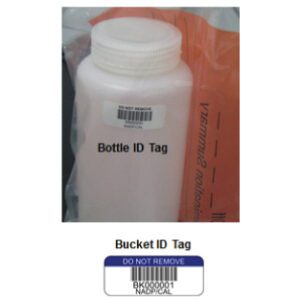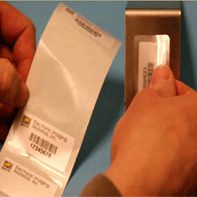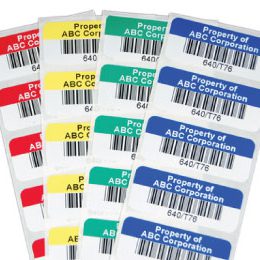Ever had to relabel a microscope slide because the original label peeled off, smeared, or disappeared completely during staining? You’re not alone. Label adhesive failure is one of the most common (and costly) problems in pathology and histology labs. If your labels aren’t sticking around for the full journey, the issue likely starts with the adhesive.
In this guide, we’ll explore why some adhesives fail, which ones hold strong, and how to select a high-performance solution for your slide labeling workflow.

Why Adhesives Matter More Than You Think
Most labeling issues in lab environments don’t stem from poor printing or facestock choice. They often come down to how well the adhesive performs under pressure, both literally and figuratively.
Whether your slides are headed for cryogenic storage, xylene staining, or a 140°C autoclave, you need an adhesive that won’t soften, crack, or lose grip.
> Common Failures in Lab Labels
- Peeling: The adhesive loses its grip during freezing or heating.
- Slipping: Labels migrate out of place during transport or centrifugation.
- Delamination: The facestock lifts away due to moisture or solvent contact.
If your lab has experienced any of these, it’s time to rethink your adhesive.
Understanding Adhesive Types for Slide Labels
Different lab conditions call for different adhesive formulations. Whether your workflow involves freezing, heating, or chemical staining, choosing the right label adhesives is critical to avoiding failure. Here’s a breakdown of common adhesive types and where they shine.
> Permanent Acrylic Adhesives
These are the most widely used in lab environments because they provide a dependable bond across a variety of conditions.
- Pros: Strong initial tack, excellent solvent resistance, and long-term durability.
- Best For: General pathology workflows, exposure to xylene and ethanol, and processes involving moderate heat.
> Cryogenic Adhesives
Cryogenic adhesives are engineered for ultra-low temperatures and maintain their grip even in extreme cold environments.
- Pros: Stay flexible and bonded in cryostorage and during dry ice transport.
- Best For: Biobank applications, frozen specimen storage, and cold-room labeling.
> High-Temp Resistant Adhesives
When slides must endure high temperatures, such as those from drying ovens or autoclaves, these adhesives prevent lifting, curling, or adhesive breakdown.
- Pros: Maintain integrity under prolonged high heat.
- Best For: Autoclaving, heat drying, and thermal processing protocols.
If your lab requires labeling through more than one of these environments, hybrid adhesives can offer multi-condition performance without compromising on bond strength or longevity.
Adhesive for Slide Labels: Matching the Chemistry to the Workflow
The type of chemicals your slides encounter can wreak havoc on poorly matched adhesives.
> Key Environmental Considerations
- Xylene and Alcohol: These solvents break down adhesives that are not designed for chemical exposure. Ensure your labels are tested specifically for solvent resistance.
- Moisture and Humidity: The wrong adhesive can fail quickly in high-humidity environments or when condensation occurs.
- Refrigeration and Freezing: Labels applied at room temperature and stored cold may lift unless the adhesive is rated for that transition.
- Autoclave Processing: Many adhesives cannot tolerate the pressure and heat of sterilization. Make sure yours is validated for these cycles.
Even the best adhesive won’t perform if it’s paired with incompatible materials or incorrect application methods.
Our labeling experts can match your slides, workflow, and environmental conditions with the perfect adhesive formulation. Reach out to Electronic Imaging Materials to request a sample kit or talk to a Label Expert.
Best Practices for Long-Lasting Adhesion
Choosing the right label adhesive is only half the battle. How you apply and store your labels has a major impact on long-term performance. Below are essential best practices to get the most from your adhesive solution, whether you’re labeling slides, vials, or lab containers.

Clean the Surface First
Adhesion starts with surface prep. Any dust, condensation, oil, or frost can interfere with bonding. Always clean the slide surface and ensure it’s completely dry before applying a label. This step is especially critical when labeling items coming out of cryogenic storage.

Apply Firm, Even Pressure
Label adhesives bond best when they make full contact with the surface. When applying adhesive, use consistent, firm pressure across the entire label. This ensures the adhesive spreads evenly and begins to cure properly, forming a strong, uniform hold.

Use Compatible Print Ribbons
Thermal transfer printing is common in labs, but not all print ribbons are equally effective. Resin-based ribbons are ideal for high-durability needs and pair well with strong adhesives. Incompatible or low-quality ribbons can weaken the label adhesive interface and increase the risk of smearing or delamination.

Mind the Storage Conditions
Even unused labels are sensitive to environmental factors. To maintain adhesive effectiveness, keep them in a controlled space with stable temperature and humidity. Avoid storing near heat sources or in direct sunlight, which can degrade the adhesive over time.

Apply Within Recommended Temperature Ranges
Each label adhesive has a minimum and maximum application temperature. Applying a label in temperatures too low or too high can compromise initial tack and overall bond. Check manufacturer specs to ensure you’re labeling within the right conditions.
How to Test If Your Labels Will Last
Are your current labels—or a new batch—up to the challenge? Before you risk a full rollout, take a few minutes to simulate real-world lab conditions. It’s one of the simplest ways to avoid costly relabeling and ensure reliable results.

Start with a clean slide.
Any dust, residue, or condensation can compromise adhesion. Wipe the glass thoroughly and allow it to dry before applying your test label.

Run your environmental gauntlet.
Expose the labeled slide to the same environments it would encounter in your workflow.
This might include: Freezing (refrigerator or cryogenic storage), Heating (drying ovens or autoclaves), Solvent exposure (xylene, ethanol, or other chemicals), Moisture or humidity, Centrifugation or automated handling

Inspect for performance after each stage.
Even a single failure point can disrupt your workflow. That’s why early-stage label testing is so important. Vetting your materials upfront prevents errors before they affect your specimens and save valuable time in the process.
Look for signs of: Peeling or curling edges, Loss of adhesion, Smudging or fading print, Label migration or slipping
When the Right Label Adhesive Makes All the Difference
Generic adhesives often fail because they are not built to handle the demanding conditions of a clinical or research lab. If your labels are peeling, shifting, or losing readability, the issue might not be your printer. It is likely the adhesive.
Electronic Imaging Materials has sourced and tested adhesives that perform under pressure. Whether your workflow involves high heat, freezing temperatures, or harsh chemical exposure, we can help you identify a proven adhesive that will hold up.
When You Should Ask for Adhesive Guidance
- Your slides move between freezing and heating environments.
- You use xylene, ethanol, or other aggressive solvents.
- You rely on automation, and label misalignment or scanning errors cannot happen.
- You need reliable performance for long-term archival storage.
We guide you to the right option from our trusted lineup, based on your specific conditions and goals. Let us help you get it right the first time.
EIM Administers Adhesives That Stick With You
Electronic Imaging Materials builds label systems around your environment, your process, and your people.
Our custom lab labels are built to endure:
- Cryogenic freezing
- Xylene staining
- Autoclave sterilization
- Long-term archiving
Need a label that sticks through it all? We’re here to help. Talk to EIM today for adhesive recommendations, testing support, or custom development that keeps your labels working as hard as your team.





